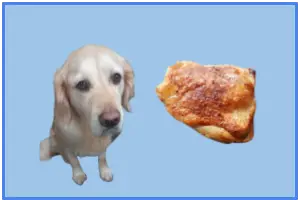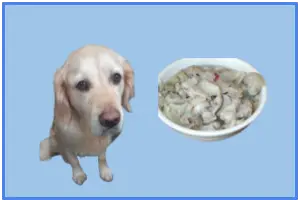
Are you looking to add more meat or protein to your dog’s diet?
Are you thinking about using chicken thighs to achieve this?
Chicken is a budget friendly meat and thighs are a very inexpensive part of the bird.
But how dog friendly are chicken thighs? Should they eat them?
Chicken thighs are a great way to add more flavour, fat, protein and calcium to your dog’s diet but there are two things to bear in mind. Firstly, there is a slim chance that a raw chicken thigh might contain nasty bacteria such as salmonella. And secondly, because chicken thighs contain a bone, we need to be careful about how we feed them to your dog.
Now we can get into the nitty gritty.
What is the nutrition in a chicken thigh?
Did you know that a typical chicken thigh contains 21% bone and 79% meat?
I have created a chart below which shows the most relevant nutrition data about chicken thighs.
To try and place it in context, I have also added the nutrition details of a piece of chicken breast.
It is for a 100g serving.
| Thigh | Breast | |
| Calories | 243 | 220 |
| Fat | 16 g | 7 g |
| Cholesterol | 129 mg | 135 mg |
| Sodium | 406 mg | 730 mg |
| Carbohydrate | – | |
| Protein | 23g | 40 g |
A thigh bone provides two main nutrients for a dog- fat and protein.
As well as that it contains large amounts of one vitamin and one mineral- vitamin B3 and selenium.
A chicken thigh is 16% fat
Some of you might be looking at the figure of 16% fat and gasping in horror- others of you might look at it with a nonchalant shrug of your shoulders.
The truth is for a healthy and active dog, with a well balanced diet, a bit of extra fat in their diet brings more pros than cons.
Let me explain.
Fat is a great source of energy for dogs.
The fat in a chicken thigh or any other part of the chicken is an omega 6 fat.
They are important when it comes to maintaining healthy muscles and nerves.
And fats help dogs to absorb some important vitamins- such as vitamin A and D.
A chicken thigh is 23% protein
It is easier to explain how protein will benefit your dog because protein has a much better “image” than fat.
And there is a crossover here,
Some of the ways that fat helps the body are the same ways in which protein helps.
For instance, both nutrients help to repair muscles in a dog’s body.
A dog needs protein to maintain a healthy coat of hair and it will also help them to boost their immune systems.
Vitamin B3 and selenium
One of the primary roles of any b vitamin is that it helps metabolism– the process by which your dog turns its food into energy.
Selenium is a trace mineral which means that it is only found in tiny amounts in a chicken thigh.
And it is thought to help metabolism as well, but specifically in the thyroid.
Having looked at the nutrition that a chicken thigh contains, I will move on to talk about the best way to prepare a chicken thigh for your dog.
Cooked vs raw vs frozen thighs
So what is the best way for your dog to eat a thigh bone?
One that has been grilled or roasted (which is how we would eat it) or is it better to keep things simple by giving it to them raw or even frozen.
There isn’t one perfect choice. Each option comes with its own set of advantages and disadvantages.
Raw chicken thighs
The great thing about raw thighs is how easy they are to feed to your dog- from packet to mouth in a few seconds, with no washing up to do.
And that is the main concern about dogs being fed raw chicken.
You see, raw chicken can be contaminated with two dangerous types of bacteria (salmonella and campylobacter.)
The chances of the raw chicken thighs that you buy being contaminated, is about 1 in 25.
Now salmonella and campylobacter can make dogs very ill but because of the way that their digestion works, the risk to them is very small.
The concern is that in a household where raw chicken is being served to dogs it can infect the people living there.
And salmonella and campylobacter are much more dangerous for humans.
Another benefit of raw chicken thighs is that the one bone which is in the thigh is a lot safer for a dog to eat than a cooked bone.
I shall explain this in more depth in the next section.
Cooked chicken thighs
A properly cooked chicken thigh will kill any bacteria which raw chicken might contain, which is great news.
Unfortunately when a bone is cooked they change from being hard but flexible to being hard and very brittle.
It is the brittleness that makes them dangerous because when they are bitten they can break up into sharp little pieces.
So cooked chicken thighs are perfect if you take the bone out first but for some people that will make the whole process very tedious…
Frozen chicken thighs
That just leaves frozen chicken thighs as an option.
If there is a way to feed your dog chicken thighs that is even easier than feeding them raw, it would be feeding them frozen.
But, freezing a bone has a similar effect on it as cooking it.
A frozen bone becomes much more brittle than a raw bone and more hazardous for a dog to eat.
Having discussed some of the different ways that you can serve chicken thighs to your dog, in the next section I will take a look at how many chicken thighs they should be eating.
How many chicken thighs should I feed my dog?
You should feed your dog three chicken thighs a day- just my little joke.
How many chicken thighs you serve your dog depends on the size of the dog and the role that chicken thighs are playing in the diet.
It is fairly obvious that large dogs need more food than small dogs and so I don’t need to explain that.
But some people will be considering using chicken thighs as part of a raw food diet and if this is the case then you need to be getting some advice from your local supplier or find an online forum.
Dogs need a specific mix of muscle meat, bone and offal to maintain a healthy diet.
They can’t survive on a diet of just chicken thighs as it will need to be mixed up with other types of meat.
If you are thinking of using chicken thighs as a form of treat, then any treats that you feed your dog shouldn’t exceed more than 10% of their overall diet.
You can find out how much food you are feeding your dog everyday (in terms of weight and calories) by looking at the packet.
The average medium sized chicken thigh weighs about 90g and contains 190 calories.
Help. My dog swallowed a chicken thigh whole
So having gone into lots of detail about the upsides and downsides of chicken thighs, in this section I want to give you some advice about what to do if your dog swallows a chicken thigh whole.
As we have said, a thigh contains only one bone which is fairly big when we compare it to the size of a dog’s throat.
The thigh poses a risk to a dog because it might get stuck in their throat.
And this will happen seconds after a dog eats it.
So if you hear your dog choking or gagging that is what has happened.
If the gagging doesn’t dislodge the bone and your dog is still choking then you should call your vet
The good news is that if your dog doesn’t choke after eating a thigh whole then they should be OK.
Photo credits
¹ Photo by sousvideguy





